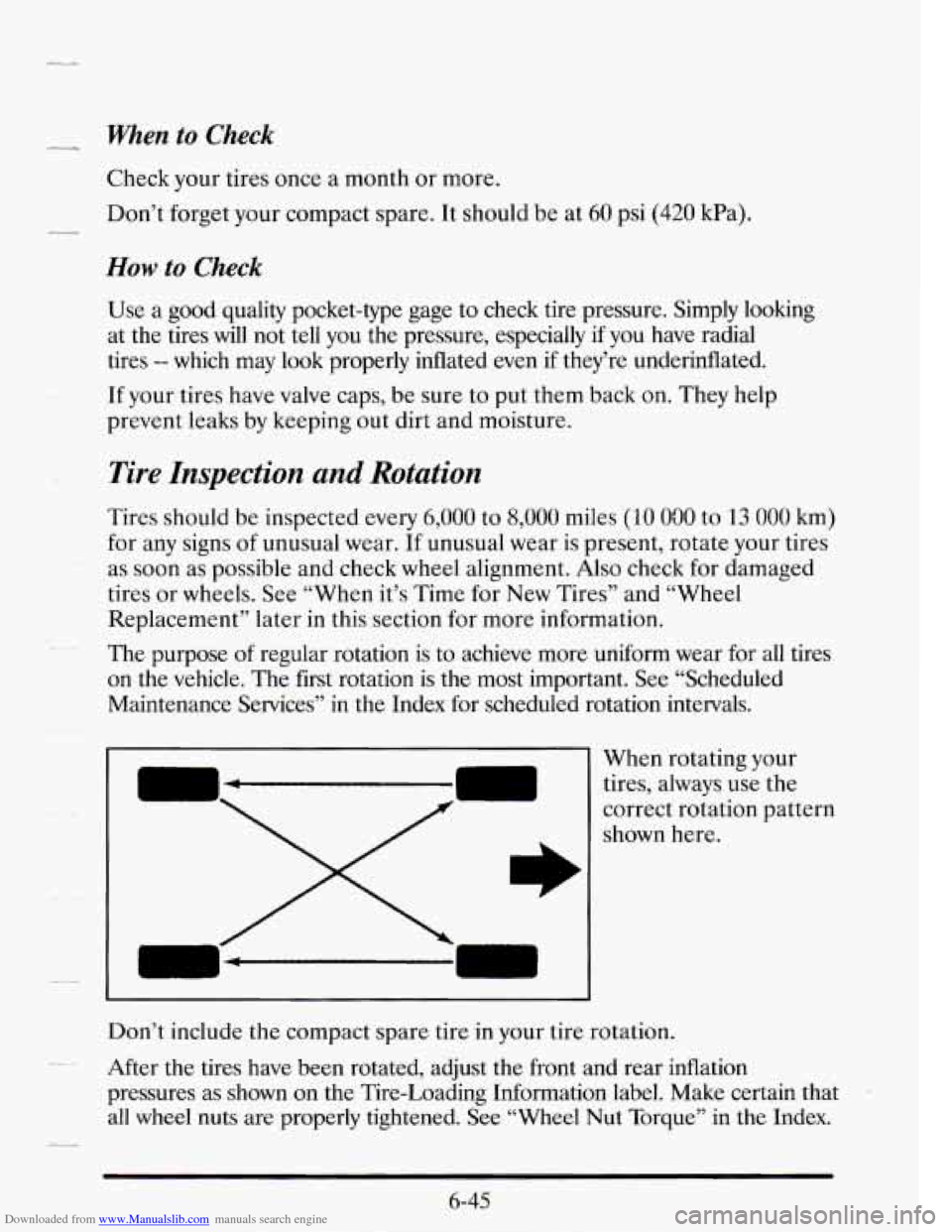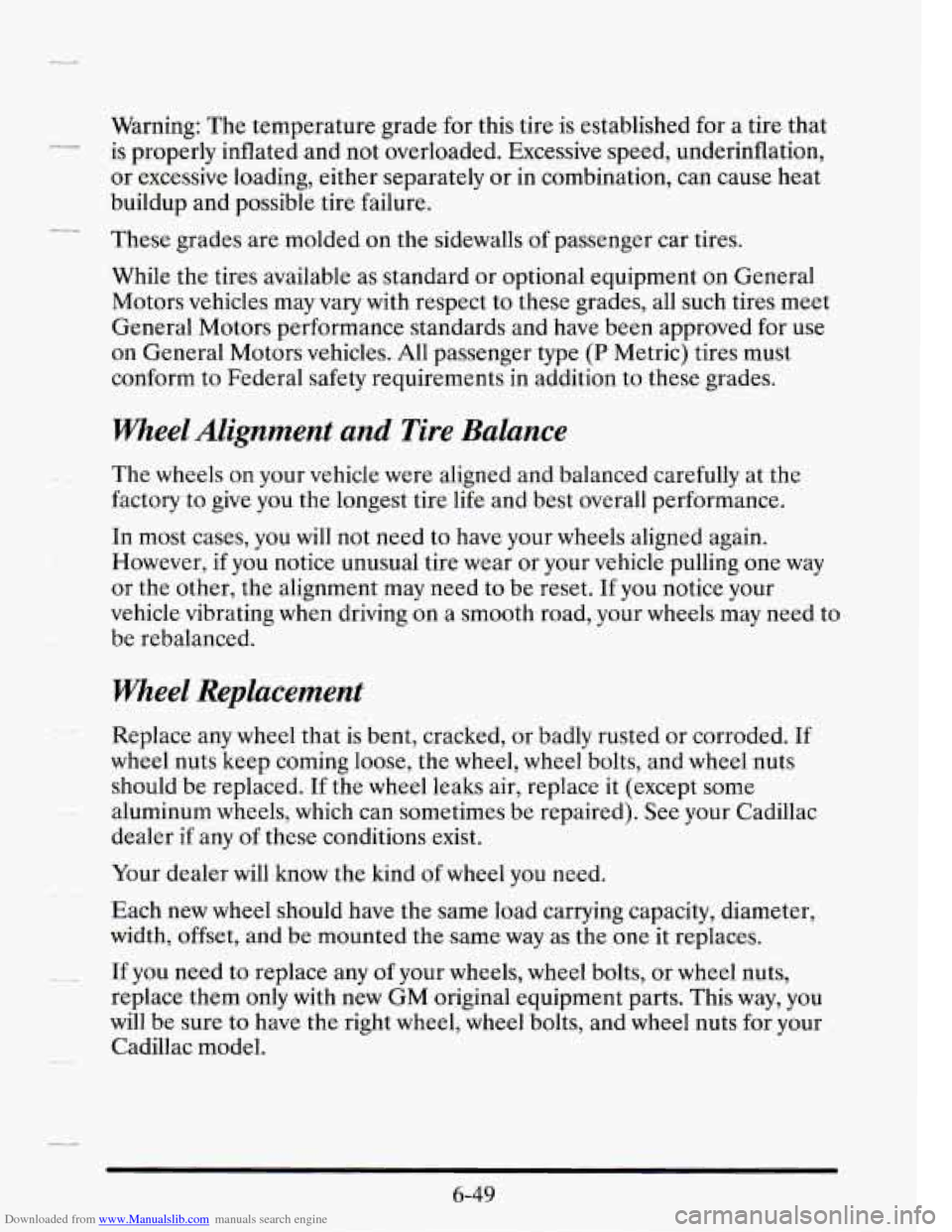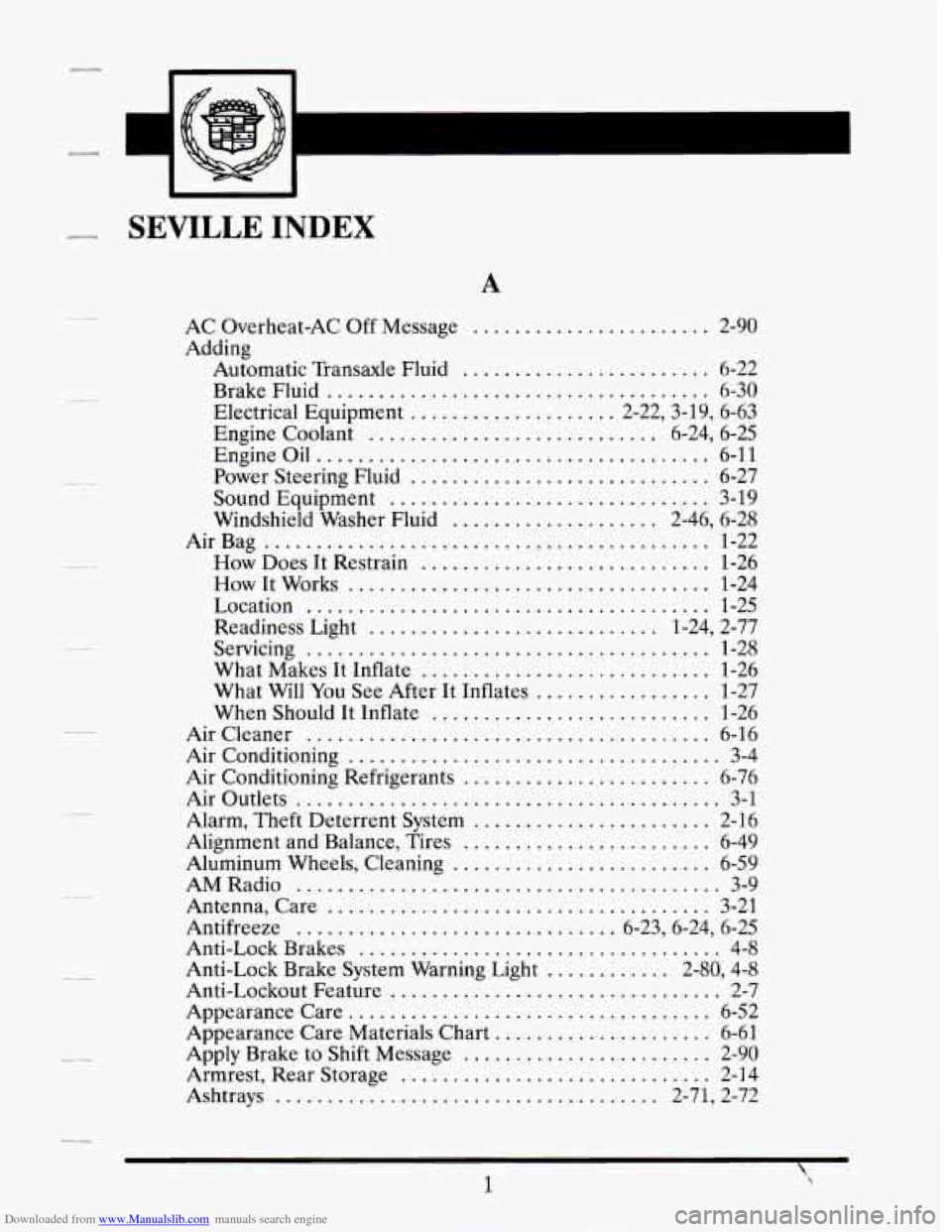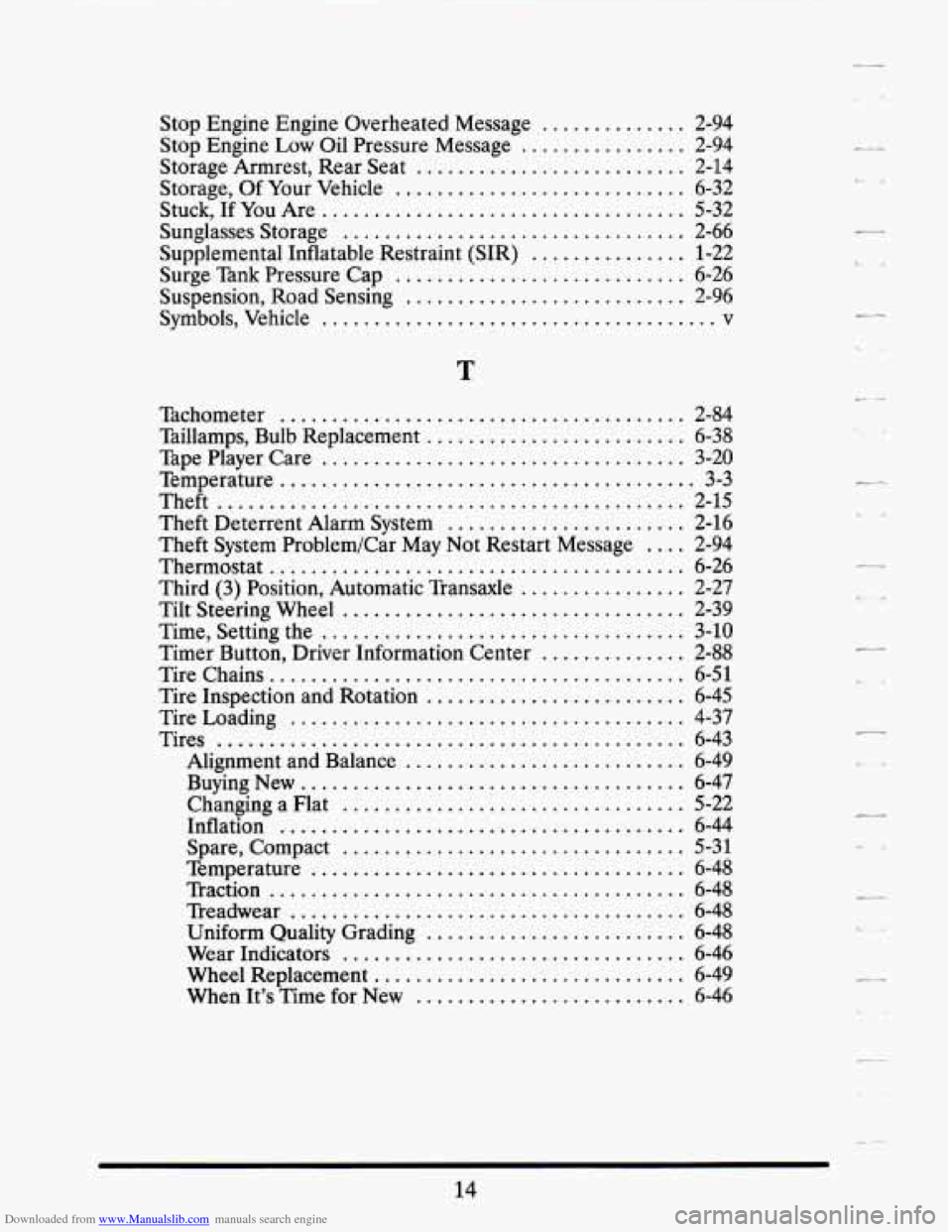1995 CADILLAC SEVILLE wheel alignment
[x] Cancel search: wheel alignmentPage 316 of 410

Downloaded from www.Manualslib.com manuals search engine When to Check
- -c
- --
c-
Check your tires once a month or more.
Don’t forget your compact spare. It should be at
60 psi (420 kPa).
How to Check
Use a good quality pocket-type gage to check tire pressure. Simply looking
at the tires will not tell you the pressure, especially if you have radial
tires
-- which may look properly inflated even if they’re underinflated.
If your tires have valve caps, be sure to put them back on. They help
prevent leaks by keeping out dirt and moisture.
Tire Inspection and Rotation
Tires should be inspected every 6,000 to 8,000 miles (10 030 to 13 000 km)
for any signs
of unusual wear. If unusual wear is present, rotate your tires
as
soon as possible and check wheel alignment. Also check for damaged
tires or wheels. See “When it’s Time for New Tires” and “Wheel
Replacement’’ later in this section
for more information.
The purpose of regular rotation is to achieve more uniform wear for all tires
on the vehicle. The first rotation is the most important. See “Scheduled
Maintenance Services” in the Index for scheduled rotation intervals.
When rotating your
tires, always use the
correct rotation pattern
shown here.
Don’t include the compact spare tire in your tire rotation.
After the tires have been rotated, adjust the front and rear inflation
pressures as shown
on the Tire-Loading Information label. Make certain that
all wheel nuts are properly tightened. See “Wheel
Nut Torque” in the Index.
6-45
Page 320 of 410

Downloaded from www.Manualslib.com manuals search engine -c
4-
--
Warning: The temperature grade for this tire is established for a tire that
is properly inflated and not overloaded. Excessive speed, underinflation,
or excessive loading, either separately or
in combination, can cause heat
buildup and possible tire failure.
These grades are molded on the sidewalls of passenger car tires.
While the tires available as standard or optional equipment on General
Motors vehicles may vary with respect to these grades, all such tires meet
General Motors performance standards and have been approved for use
on General Motors vehicles. All passenger type
(P Metric) tires must
conform
to Federal safety requirements in addition to these grades.
Wheel Alignment and Tire Balance
The wheels on your vehicle were aligned and balanced carefully at the
factory to
give you the longest tire life and best overall performance.
In most cases, you
will not need to have your wheels aligned again.
However,
if you notice unusual tire wear or your vehicle pulling one way
or the other, the alignment may need to be reset. If you notice your
vehicle vibrating when driving on a smooth road, your wheels may need to
be rebalanced.
Wheel Replacement
Replace any wheel that is bent, cracked, or badly rusted or corroded. If
wheel nuts keep coming loose, the wheel, wheel bolts, and wheel nuts
should be replaced. If the wheel leaks air, replace
it (except some
aluminum wheels, which can sometimes be repaired). See your Cadillac
dealer
if any of these conditions exist.
Your dealer will know the kind of wheel you need.
Each new wheel should have the same load carrying capacity, diameter,
width, offset, and
be mounted the same way as the one it replaces.
- If you need to replace any of your wheels, wheel bolts, or wheel nuts,
replace them only with new GM original equipment parts. This way, you
will be sure to have the right wheel, wheel bolts, and wheel nuts for your
Cadillac model.
6-49
Page 393 of 410

Downloaded from www.Manualslib.com manuals search engine .
.
..
.
.
.
3 .
SEVILLE INDEX
A
AC Overheat-AC Off Message ....................... 2-90
Adding Automatic Transaxle Fluid
........................ 6-22
Brake Fluid
..................................... 6-30
Electrical Equipment
.................... 2.22. 3.19. 6-63
Engine Coolant
............................ 6.24. 6.25
Engine Oil
...................................... 6-11
Power Steering Fluid
............................. 6-27
Sound Equipment
............................... 3-19
Windshield Washer Fluid
.................... 2.46. 6.28
Air Bag
........................................... 1-22
How
Does It Restrain ............................ 1-26
How It Works
................................... 1-24
Location
....................................... 1-25
Readiness Light
............................ 1.24, 2.77
Servicing
....................................... 1-28
What Makes It Inflate
............................ 1-26
What Will
You See After It Inflates ................. 1-27
When Should It Inflate
........................... 1-26
Aircleaner
....................................... 6-16
Air Conditioning .................................... 3-4
Air Conditioning Refrigerants
........................ 6-76
Air Outlets
......................................... 3-1
Alarm. Theft Deterrent System ....................... 2-3.6
Alignment and Balance. Tires
........................ 6-49
Aluminum Wheels. Cleaning
......................... 6-59
AM Radio
......................................... 3-9
Antenna. Care ..................................... 3-21
Antifreeze
............................... 6.23.6.24. 6.25
Anti-Lock Brakes
................................... 4-8
Anti-Lock Brake System Warning Light ............ 2.80. 4.8
Anti-Lockout Feature
................................ 2-7
Appearance Care
................................... 6-52
Appearance Care Materials Chart
..................... 6-61
Apply Brake to Shift Message
........................ 2-90
Armrest. Rear Storage
.............................. 2-14
Ashtrays
..................................... 2.71. 2.72
1
.
Page 406 of 410

Downloaded from www.Manualslib.com manuals search engine .
Stop Engine Engine Overheated Message .............. 2-94
Stop Engine Low Oil Pressure Message ................ 2-94
Storage Armrest. Rear Seat .......................... 2-14
Storage. Of Your Vehicle ............................ 6-32
Stuck. If You Are ................................... 5-32
Sunglasses Storage ................................. 2-66
Supplemental Inflatable Restraint (SIR) ............... 1-22
Surge lknk Pressure Cap ............................ 6-26
Suspension. Road Sensing ........................... 2-96
Symbols. Vehicle ...................................... v
T
Tachometer ....................................... 2-84
Taillamps. Bulb Replacement ......................... 6-38
Tape Player Care ................................... 3-20
Temperature ........................................ 3-3
Theft ............................................. 2-15
Theft Deterrent Alarm System ....................... 2-16
Theft System Problem/Car May Not Restart Message .... 2-94
Thermostat ........................................ 6-26
Third (3) Position. Automatic Transaxle ................ 2-27
Tilt Steering Wheel ................................. 2-39
Time. Setting the ................................... 3-10
Timer Button. Driver Information Center .............. 2-88
Tire Chains ........................................ 6-51
Tire Inspection and Rotation ......................... 6-45
Tire Loading ...................................... 4-37
Tires ............................................. 6-43
Alignment and Balance ........................... 6-49
Buying New ..................................... 6-47
Changing a Flat ................................. 5-22
Inflation ....................................... 6-44
Spare. Compact ................................. 5-31
Temperature .................................... 6-48
Traction ........................................ 6-48
Treadwear ...................................... 6-48
Uniform Quality Grading ......................... 6-48
Wear Indicators ................................. 6-46
Wheel Replacement .............................. 6-49
When It's Time for New .......................... 6-46
1-4.
L-
c-
i. ..
.-
.
.--.-
L- A
..
14